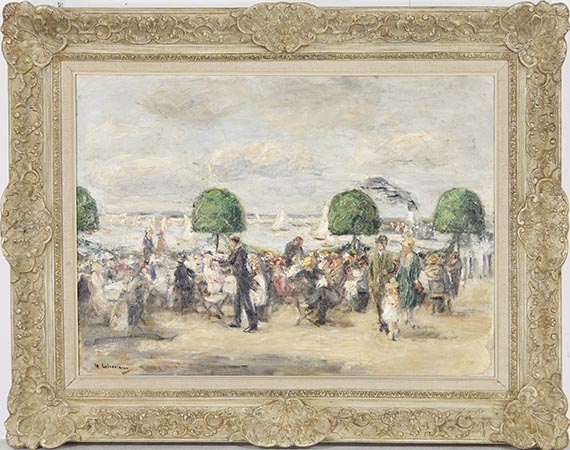301
Max Liebermann
Gartenlokal am Wannsee - Schwedischer Pavillon, Um 1925.
Olio su tela
Stima:
€ 150,000 / $ 174,000 Risultato:
€ 177,800 / $ 206,248 ( commissione inclusa)
Gartenlokal am Wannsee - Schwedischer Pavillon. Um 1925.
Oil on canvas.
Lower left signed. 54.5 x 75 cm (21.4 x 29.5 in).
[KT].
• Paintings from the 1920s are among Liebermann's most sought-after works on the international art market.
• In 1910, Liebermann moved into his villa with a studio on Wannsee, where he used to spend the summer months.
• The glamorous lakeside restaurant "Schwedenpavillon", a few minutes from the villa, was a meeting place of the high society.
• Rare characteristic and unmistakable depiction of this special garden restaurant.
• Emblematic motif of Impressionism, of which Liebermann is considered the most important German representative.
• Offered on the international auction market for the first time (source: artprice.com)).
We are grateful to Drs. Margreet Nouwen, Berlin, who inspected the work's physical condition, for her kind support in cataloging this lot. The work will be included into the addenda of the catalogue raisonné of paintings.
PROVENANCE:
Private collection Bavaria (family-owned for two generations).
Oil on canvas.
Lower left signed. 54.5 x 75 cm (21.4 x 29.5 in).
[KT].
• Paintings from the 1920s are among Liebermann's most sought-after works on the international art market.
• In 1910, Liebermann moved into his villa with a studio on Wannsee, where he used to spend the summer months.
• The glamorous lakeside restaurant "Schwedenpavillon", a few minutes from the villa, was a meeting place of the high society.
• Rare characteristic and unmistakable depiction of this special garden restaurant.
• Emblematic motif of Impressionism, of which Liebermann is considered the most important German representative.
• Offered on the international auction market for the first time (source: artprice.com)).
We are grateful to Drs. Margreet Nouwen, Berlin, who inspected the work's physical condition, for her kind support in cataloging this lot. The work will be included into the addenda of the catalogue raisonné of paintings.
PROVENANCE:
Private collection Bavaria (family-owned for two generations).
In the 1920s, the so-called ‘Swedish Pavilion’ on Wannsee, with its seaside terrace bordered by small, trimmed box trees and garlands of leaves, was a popular day-trip destination for Berliners escaping the city in summer. The original eponymous wooden building was purchased from the 1873 Vienna World's Fair, and was expanded to become a large building in the style of an English country house in 1909/10. During these years, Max Liebermann also moved his summer residence to his lakeside property with a villa on Wannsee, just a few minutes walk from the Swedish Pavilion on Grosse Seestrasse. From then on, motifs from his garden, which he had planned together with Alfred Lichtwark, or the Sunday strollers on Große Seestraße, as well as scenes the from the garden cafes gained in importance in his impressionist repertoire. With the arising troubles in the Berlin Secession and eventually the outbreak of World War One, Liebermann increasingly retreated to this refuge, where a large part of paintings characterized by a light-filled palette were made in a summery ambiance. Since the beginning of his artistic career, Liebermann had been concerned with the challenging depiction of multi-figure groups, their arrangement in the pictorial space and the distribution of light, color and movement: "I wanted to have my cake and it too by trying to take account of both movement and colors in the picture" (quoted from: Eberle, Vol. II, Munich 1996, p. 796). Famous models such as Edouard Manet's "Tuileries Garden" from 1862 or August Renoir's "Dance at Le moulin de la Galette" from 1876 establish a motif that would become iconic of Impressionism. Liebermann revisited this tradition in his "Münchner Biergarten” (Munich Beer Garden, 1884, Neue Pinakothek, Munich), in the 1920s, when Liebermann dissolved the scenery in color, light and movement, the subject reached a peak of painterly freedom. The staffage with the white sailing boats and the steamer, a waiter in tails and the leaving couple with their daughter in a white dress embody the epitome of a carefree harmony. On the occasion of his 80th birthday in 1927, the Prussian Academy of Arts organized an honorary banquet with 120 guests from Germany and abroad at the Swedish Pavilion, an event to which the unpretentious Liebermann could simply walk over from his villa. [KT]
301
Max Liebermann
Gartenlokal am Wannsee - Schwedischer Pavillon, Um 1925.
Olio su tela
Stima:
€ 150,000 / $ 174,000 Risultato:
€ 177,800 / $ 206,248 ( commissione inclusa)




 Lot 301
Lot 301 
